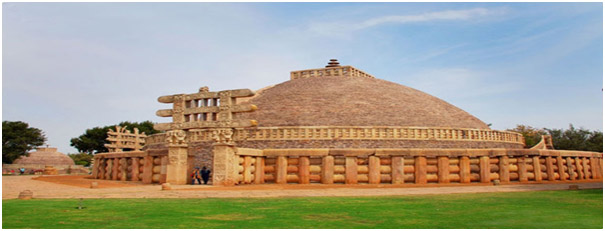06 Nights 07 Days
Bhopal- Ujjain- Indore- Mandu- Maheshwar- Omkareshwar- Jalgaon- Aurangabad

Day 01: Arrival Bhopal
On arrival at Bhopal transfer to hotel later proceed for sightseeing of Bhojpur temple having largest shiva-linga of 7 ft. high. Bhojpur is a small town on the bank of Betwa river. Temple is unique in many manner as massive stone blocks were used in construction and was called Somnath Temple of East. After visiting Bhojpur temple, proceed UNESCO World Heritage site: Bhimbetka rock shelters. These rock-shelters offer pre-historic rock paintings to examine. After Bhimbetka visit, return back to hotel in Bhopal to have lunch. After lunch, we will go for another UNESCO World Heritage Site called Sanchi Stupa, located at a distance of 45 kms from Bhopal city.
Overnight Hotel.
Day 02 Bhopal- Ujjain- Indore (240 Kms/ 06 Hrs)
Morning after Breakfast drive to Indore Enroute visit Ujjain, Ujjain is an ancient city in western Madhya Pradesh of Central India, on the bank of Kshipra river. It is known as important pilgrimage city for followers of Hindu religion. Mahakaleshwar temple of Ujjain is one of the 12 jyotirlinga of India. Here Kumbh mela is held in every 12 years. Sandipani ashram in city is known as school of Lord Krishna, Balrama & Sudama. Places to visit in Ujjain are : Mahakaal temple, Ved Shala (observatory), Sandipani ashram, Chintaman Ganesh temple, Iskcon temple, Jain temples, Kalabhairav temple, Bhadrakali temple etc. Later drive to Indore on arrival transfer to the hotel.
Overnight Hotel
Day-03 : Indore- Mandu (100 Kms/2 Hrs)
After breakfast, leave for “City of Joy” called Mandu. On reaching Mandu, appointed local guide will take us for local sightseeing of Mandu city. Mandu in Dhar district of Madhya Pradesh State in Central India, is a historical city. Mandu city is stretched over13 kms belt on crest of Vindhya range, close to Narmada river valley. History of Mandu goes back to 6th century. Monument in Mandu were built in 14th & 15 century itself. Places to visit in Mandu are: Roopmati pavallion, Buland Darwaza (Darwaza means Gate), Jahaz Mahal, Hindola Mahal, Jami Masjid, Baz Bahadur Mahal, Rewa Kund, Hoshang Shah Tomb, Echo point etc. Ideal Mandu sightseeing is two days but must see points can be covered in single day sightseeing. Baobab tree in Mandu is another amazing thing to watch as it is rarely seen in India.
Overnight Hotel.
Day 04: Mandu- Maheshwar (60 Kms/ 01 Hrs)
Morning half-day visit to monument left in first day sightseeing. Later, after lunch drive towards pilgrimage town Maheshwar about 65kms from Mandu. Do local sightseeing of holy town on the bank of Narmada river.
Maheshwar in west part of Madhya Pradesh State in Central India. In Hindu religious books like Ramayan & Mahabharat, it is referred by the name of Mahismati, capital of King Kartivarjun. Places to visit in Maheshwar are : Maheshwar fort, Rajarajeshwara Temple, Kaleshwara Temple, Narmada Ghats, manufacturing units of Maheshwari Silk Sarees (Indian women traditional outfit) etc. Current Historical look of Maheshwar was result of efforts of Holkar Queen – Rani Ahilyabai in whose reign, many famous temples were constructed due to her efforts.
Overnight Hotel.
Day 05: Maheshwar- Omkareshwar- Jalgaon
On reaching Omkareshwar, we will do guided half day tour of the temples. It is at the confluence of Narmada & Kaveri rivers. After having lunch in Omkareshwar, we move towards Jalgaon city (270kms / 06:00hrs) for overnight stay. To reach Jalgaon city, we will enter into Maharashtra state from Madhya Pradesh state.
Overnight Hotel
Day 06: Jalgaon- Ajanta- Aurangabad
Day will be dedicated tour of UNESCO World Heritage Site : Ajanta. It is about 80 kms from Jalgaon city. Here we will do full day sightseeing go Buddhist religious art with the help of our guide.
Ajanta caves are recognized by UNESCO in year 1983 (Ref. 242). Here we can find 30 rock-cut man-made caves, inside which we can find artistic pictures of Lord Buddha’s life and Buddhism. These caves were discovered in April, 1819 by British officer Captain Smith when he was in Tiger trail. Oldest cave was of 2nd BC and others are of Gupta period (5th AD to 6th AD). Paintings and Sculptures in Ajanta are believed to the masterpieces of Buddhist religious art. They had a considerable artistic influence in work. After Ajanta sightseeing, drive to another historical city Aurangabad (120kms / 03:00 hrs drive).
Overnight Hotel
Day 07: Aurangabad- Ellora – Aurangabad Departure
Morning breakfast and then proceed for sightseeing of another UNESCO World Heritage Site: Ellora monasteries & temples at a distance of 35 kms / 01:00 hrs drive from Aurangabad city. We will do the whole sightseeing with the help of our guide.
Ellora monasteries and temples were recognized as UNESCO World Heritage Site in 1983 along with Ajanta caves. There are 34 monasteries and temples in a stretch of 2 kms. These temples were dug in a side by side fashion in a high basalt cliff in Chandranandri Hills. These monuments were of age in between A.D. 600 to 1000. They were engraved during the reign of Rashtrakuta rulers. These monasteries and temples were of Buddhist (from 1-12), Hindu (from 13-29) and Jain (from 30-34) religions.Later transfer to Aurangabad Airport to board your onward flight.
